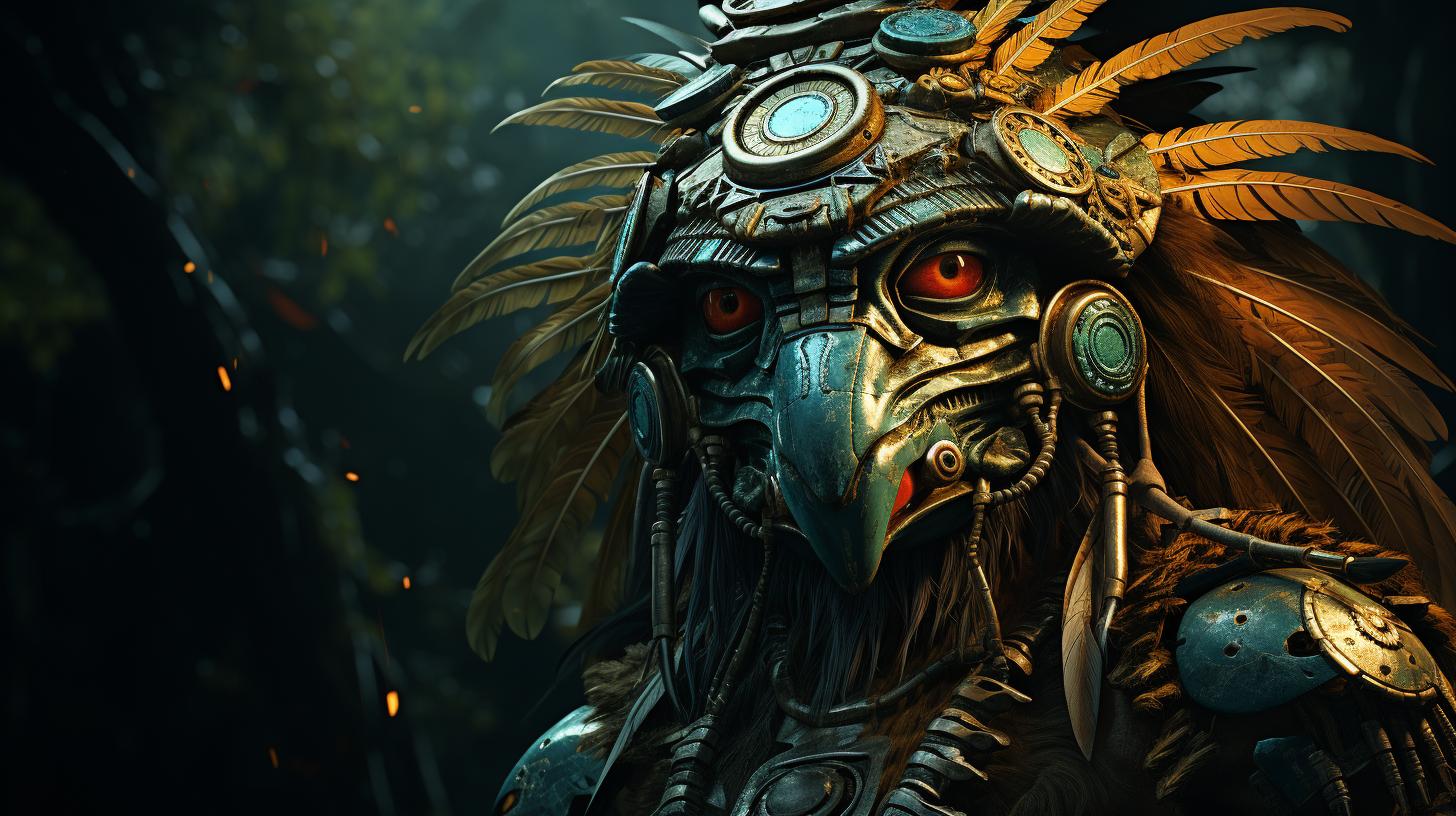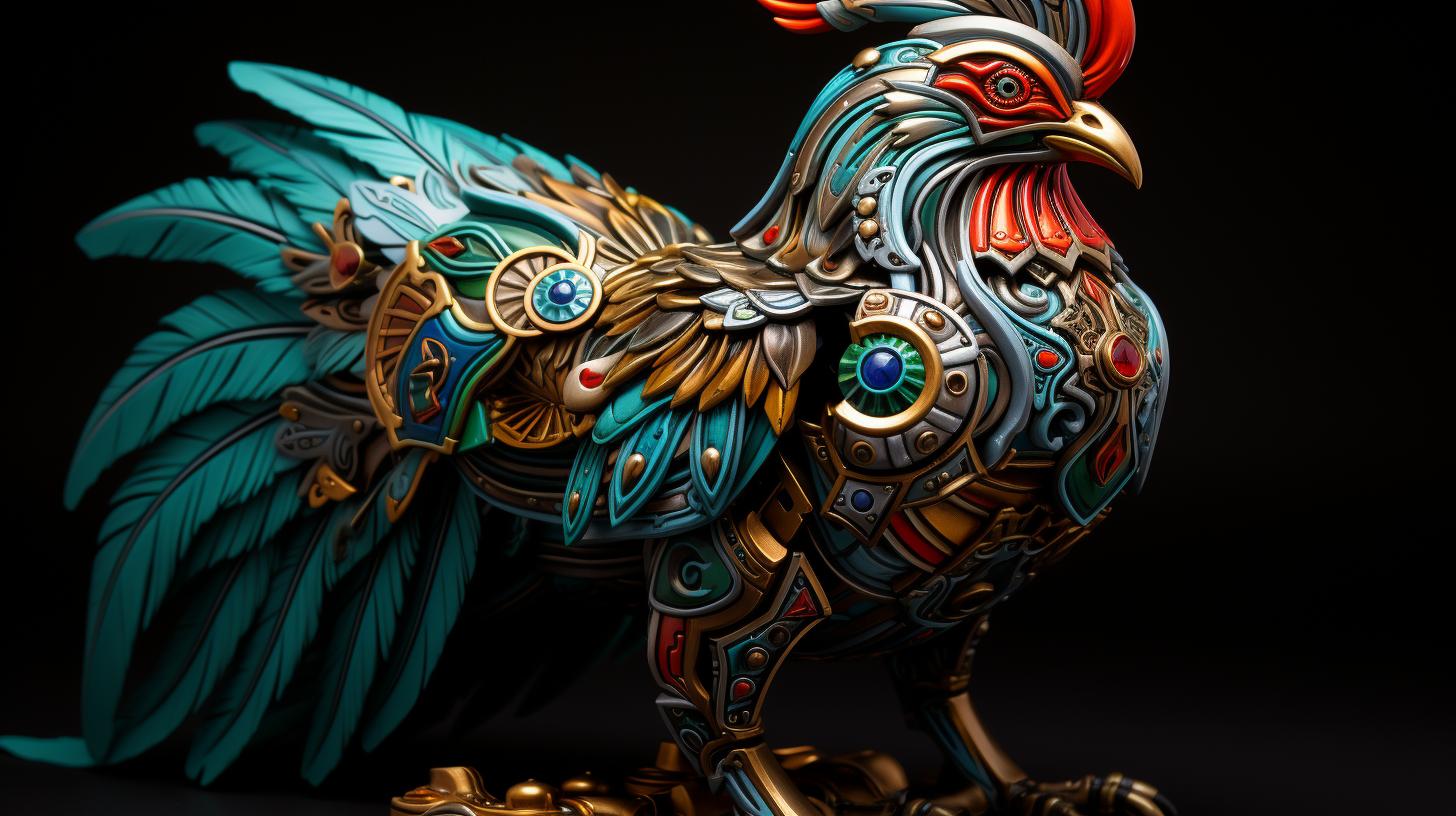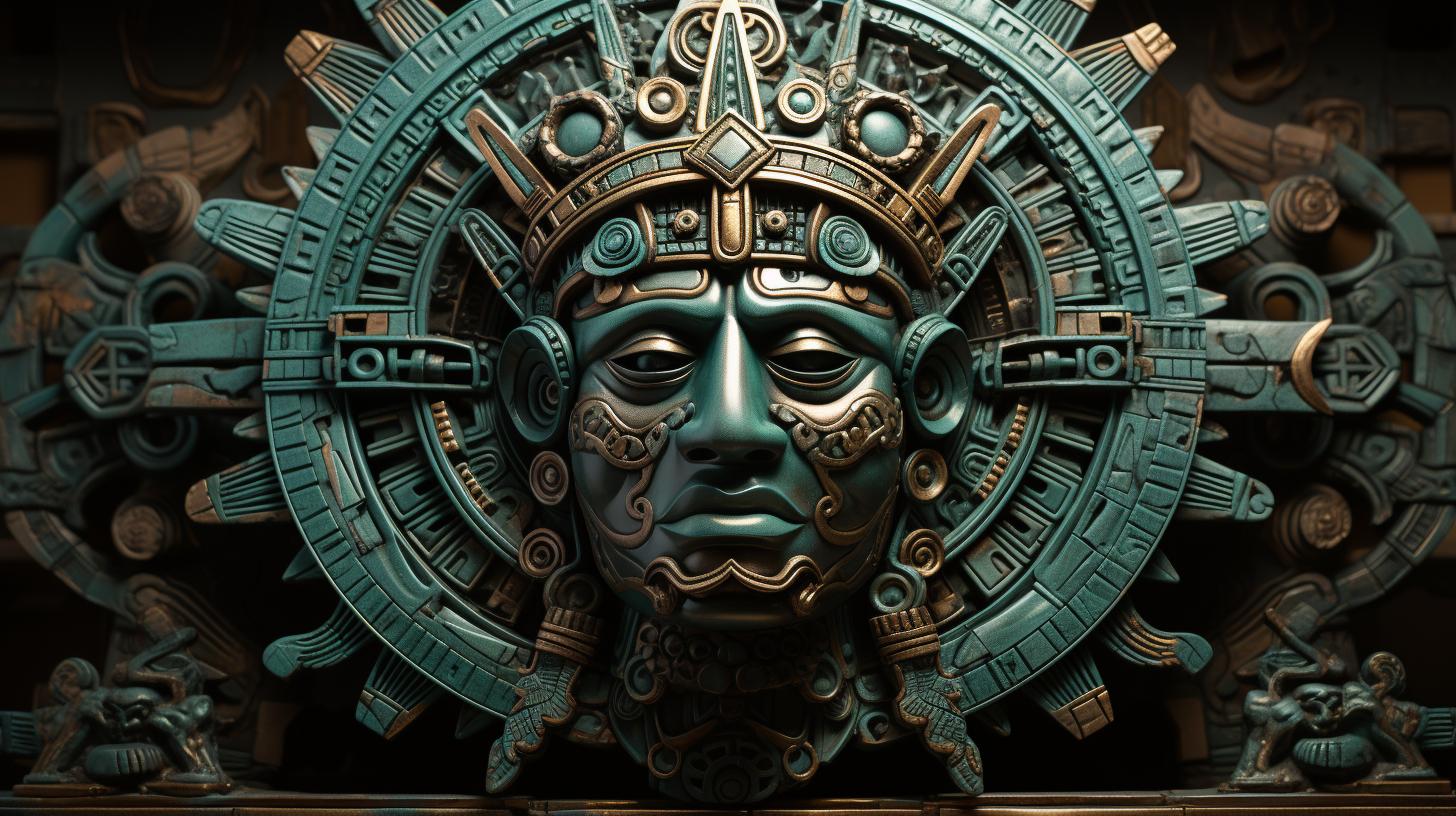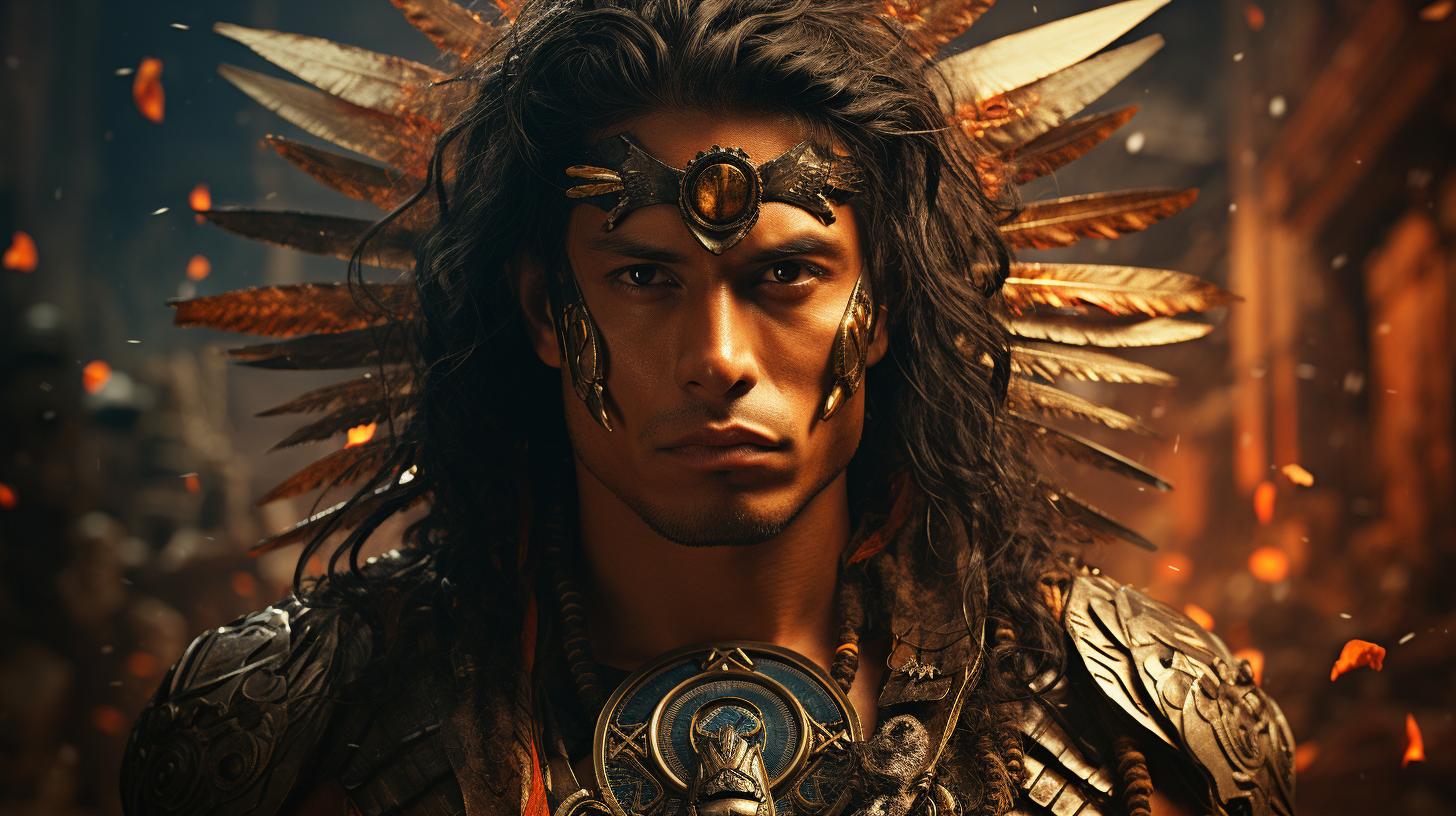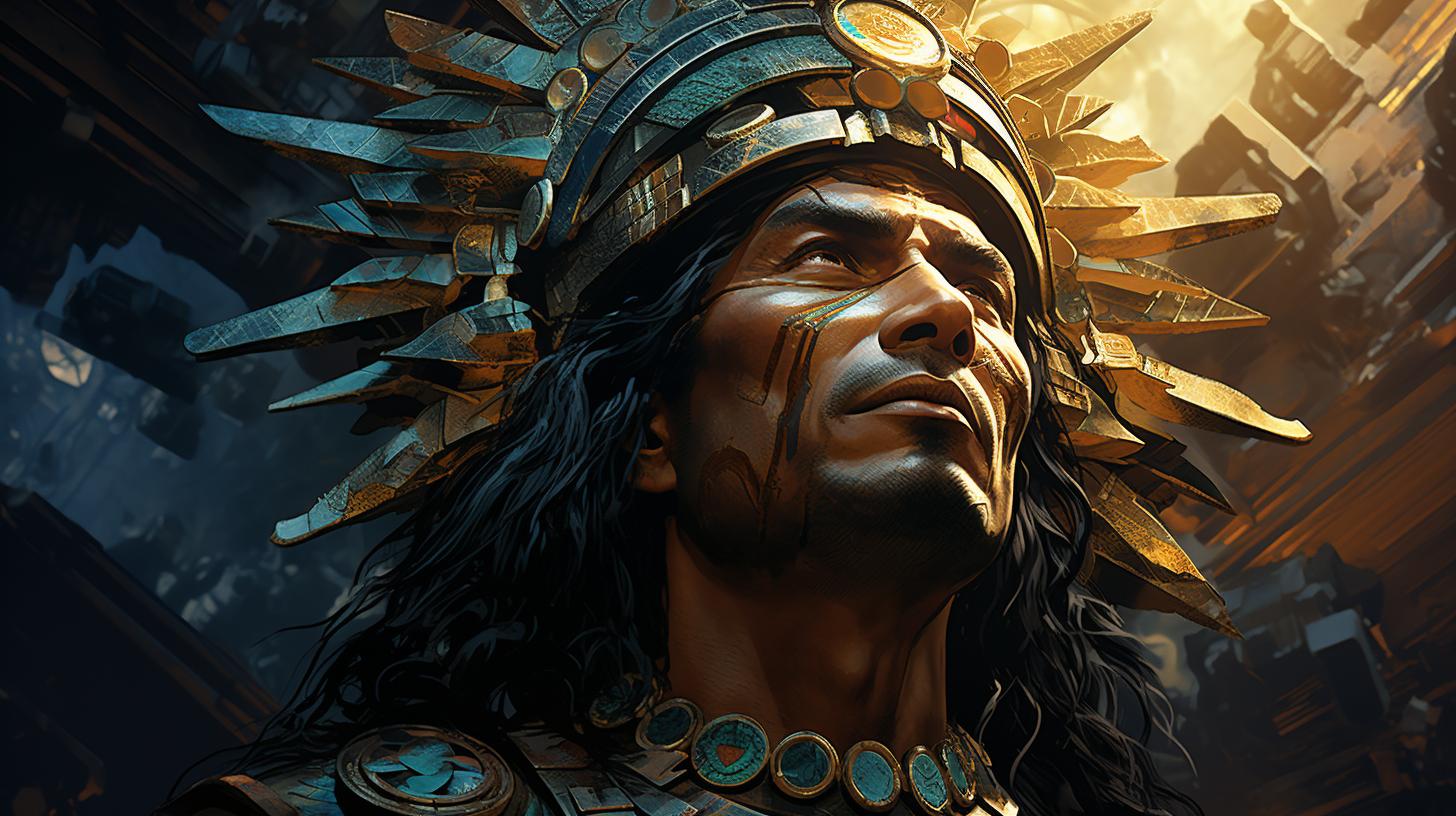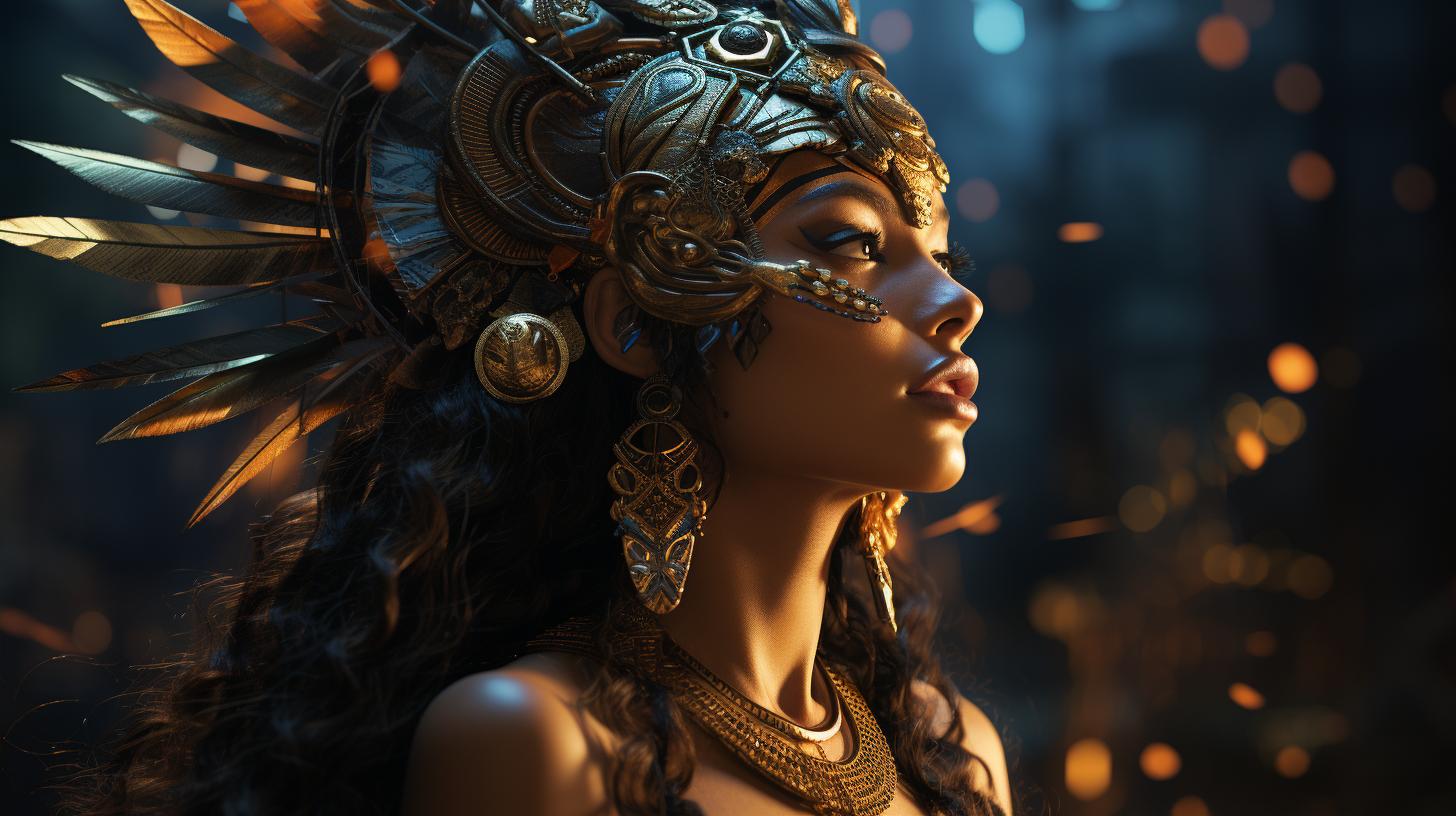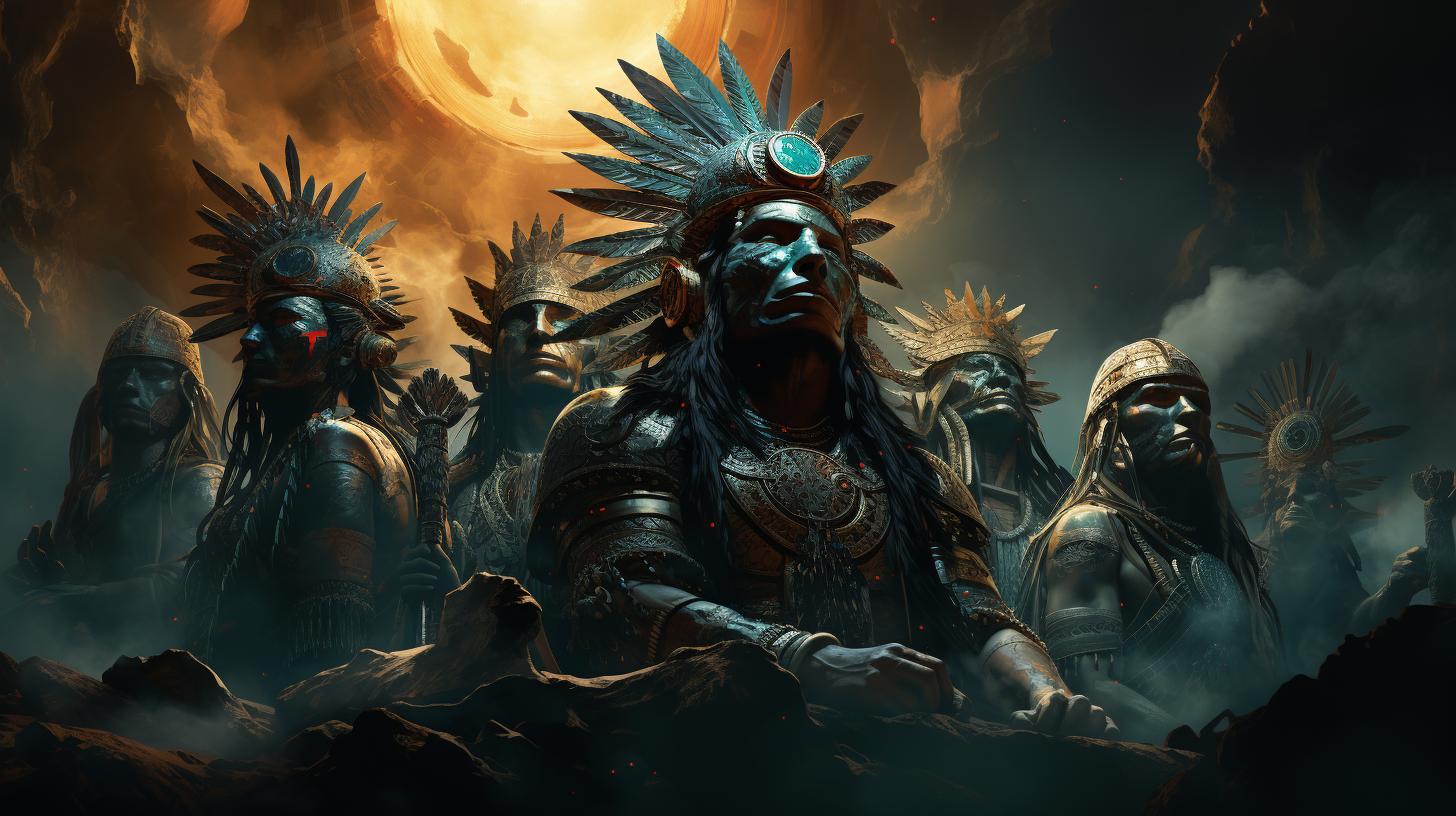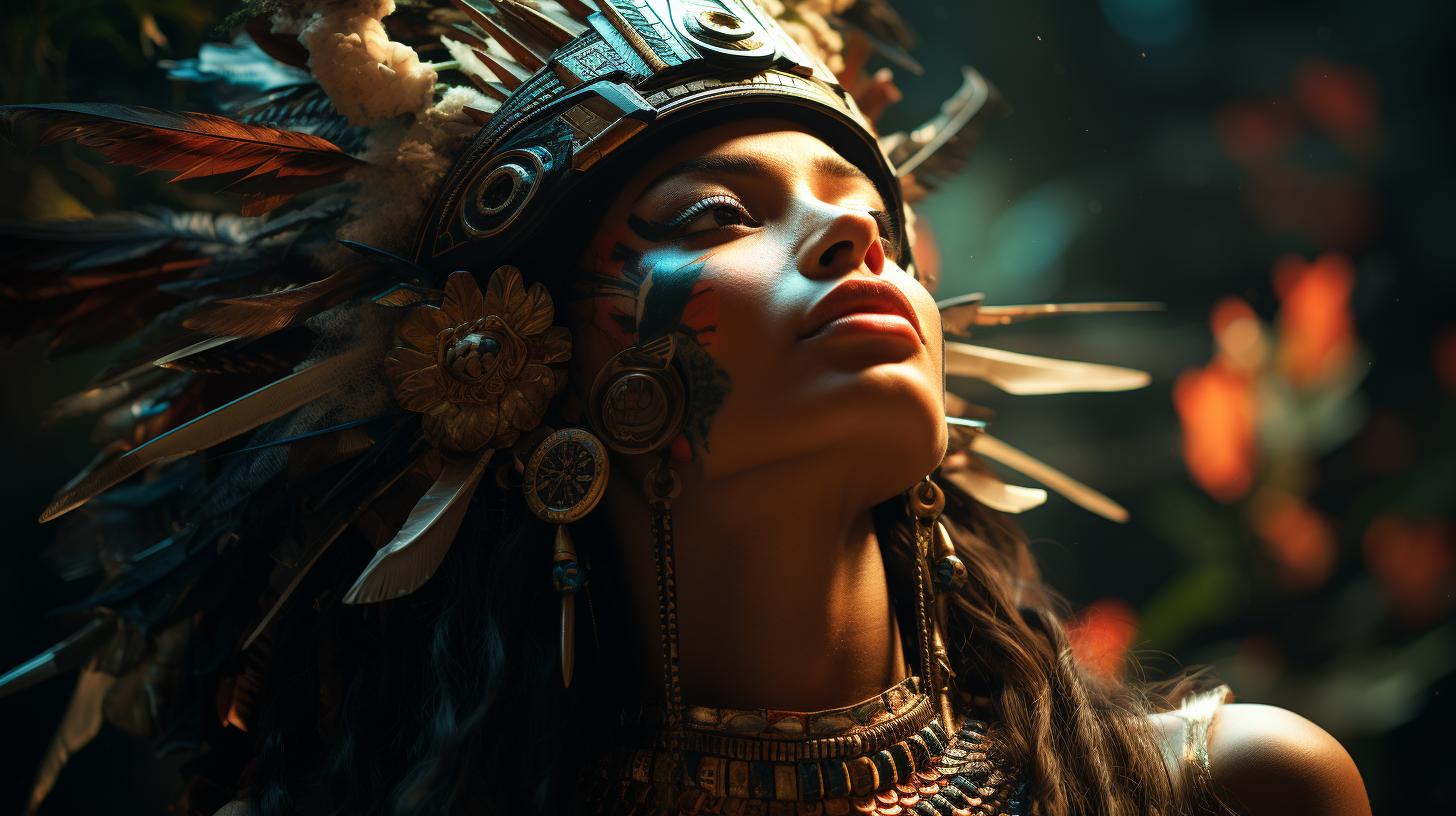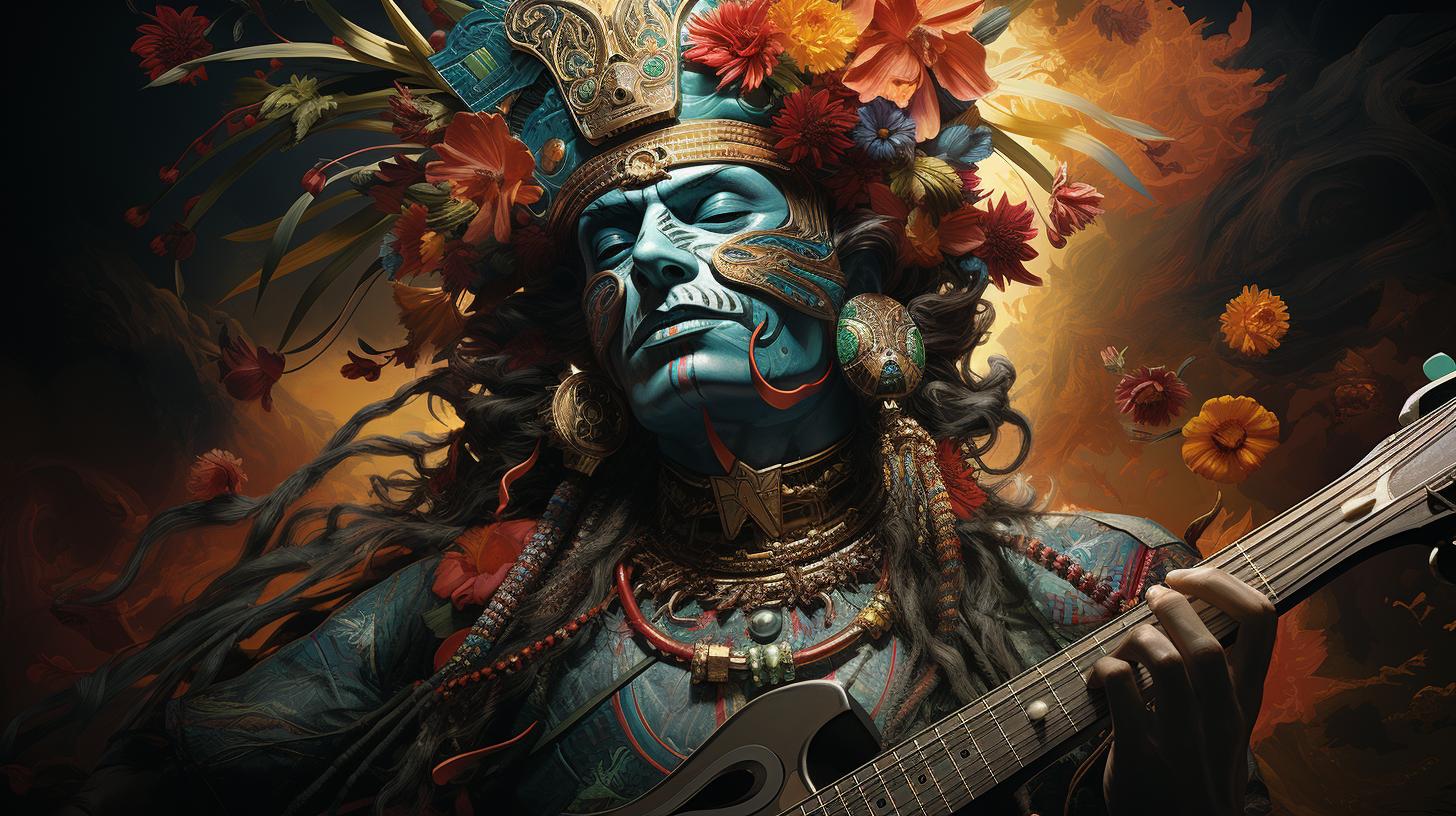Opochtli Aztec God: Exploring the Powerful Deity of Aztec Mythology
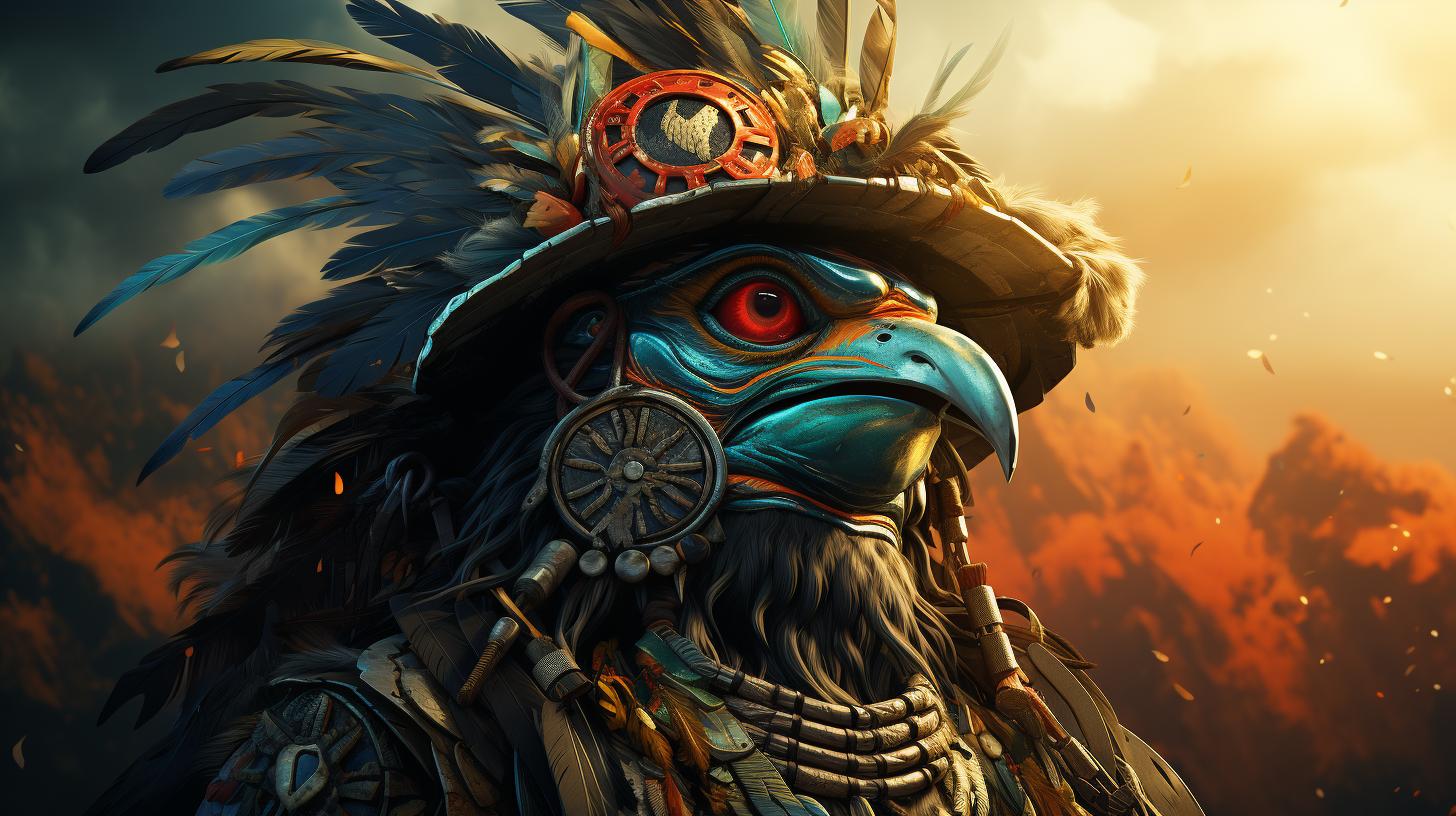
Opochtli Aztec god is a significant deity in Aztec mythology, associated with fishing, hunting, and fertility. This god was primarily worshipped in Tlatelolco, near Mexico City, and had a dedicated temple called Templo Mayor.
Opochtli’s appearance features a black-painted naked man adorned with wild bird feathers, a crown, a red shield, and a white flower. He is also known for his connection to nature and his transformative role in the cycles of life.
Explore the rich mythology, symbolism, and cultural impact of Opochtli, the revered Aztec god.
What is Opochtli: Exploring the Aztec God of Fishing, Hunting, and Fertility
Opochtli, a significant deity in Aztec mythology, holds a unique position as the god of fishing, hunting, and fertility. This intriguing figure encompasses the power of nature and symbolizes the interplay between humans and their environment.
Exploring the multifaceted nature of Opochtli allows us to delve into the rich tapestry of Aztec culture.
In Aztec beliefs, Opochtli was revered for his ability to provide sustenance through fishing and hunting.
He held special significance in coastal communities, where reliance on marine resources was vital. Opochtli’s representation of fertility further emphasized his importance in agricultural practices, as the Aztecs depended on strong crops for survival.
By examining Opochtli’s role in Aztec society, we can understand how this deity influenced various aspects of daily life. From rituals and offerings in dedicated temples to festivals and ceremonies celebrating his power, Opochtli’s presence was deeply ingrained in Aztec culture.
As we explore Opochtli’s symbolism, we uncover the profound connection between the god and nature. His transformational abilities mirror the cyclical patterns of life, encompassing the dawn and dusk, seasonal changes, and the growth of crops.
Opochtli embodies the harmony between humans and the natural world.
Join us on this journey as we unravel the mysteries of Opochtli, discovering the profound impact of this Aztec god on the realms of fishing, hunting, and fertility.
Let’s delve into the multifaceted nature of this deity and gain a deeper appreciation for the intricate tapestry of Aztec mythology.
The Mythology of Opochtli: Background and Origins in Aztec Culture
Opochtli, an esteemed deity in Aztec mythology, bears a rich mythological background deeply rooted in Aztec culture.
Within this intricate belief system, Opochtli holds a significant position as the god of fishing, hunting, and fertility. His origins can be traced back to Coatlicue, the goddess of the earth, as his mother, and Mixcoatl, the god of hunting, as his father.
Opochtli’s siblings include the moon goddess Coyolxauhqui and the sun and war god Huitzilopochtli, among others.
Opochtli’s presence in the Aztec pantheon symbolizes the interconnection between humanity and the natural world. As a god associated with fishing, hunting, and fertility, Opochtli embodies the divine power and beauty found in nature.
His role extends beyond merely providing sustenance, representing the transformative forces of the environment. The cyclical patterns of sunrise and sunset, seasonal changes, and crop growth all find resonance with Opochtli’s influence.
Understanding the mythology and origins of Opochtli provides valuable insights into the Aztec culture’s beliefs and reverence for the natural world. Through the exploration of Opochtli’s story, we gain a deeper appreciation for the complex tapestry of Aztec spirituality and the profound significance of this deity within their cosmology.
Opochtli’s Appearance and Symbolism: Unraveling the Visual Representations of the Deity
Opochtli, the revered Aztec god, is depicted in a visually striking manner that embodies his divine attributes and symbolic significance. As we unravel the visual representations of this deity, we come across a mesmerizing portrayal that captivates the imagination.
Opochtli is envisioned as a black-painted nude figure, adorned with magnificent feathers from wild birds, creating a crown-like headpiece. This distinctive presentation exudes an air of power and mystique. In his left hand, he holds a vibrant red shield, symbolizing protection and defense.
Contrasting this, his right hand delicately holds a pure white flower, representing purity and beauty.
The adornments adorning Opochtli further accentuate his divine status. He wears a headdress made of shells and feathers, evoking a connection to the natural world.
His serious expression reflects his role as a guardian and provider, while his strong physique embodies his association with hunting and fishing.
Opochtli’s visual representations also speak to his transformative nature.
He is often depicted with a hunting weapon, honoring his role as a skilled provider. His presence is accompanied by a fishing net, symbolizing fertility and abundance. These visual cues embody the cyclical nature of life, drawing parallels to the sunrise and sunset, seasons, and agricultural growth.
Through the symbolism embedded in Opochtli’s appearance, we gain a deeper understanding of his multifaceted role in Aztec mythology. As we delve further into the realms of this ancient tradition, we discover the profound connections between visual representation and the divine essence of Opochtli, the god of fishing, hunting, and fertility.
Opochtli’s Role in Aztec Pantheon: Connections with Other Gods and Goddesses
Opochtli, the revered Aztec god, held a significant place within the intricate web of deities in the Aztec pantheon. As the god of fishing, hunting, and fertility, Opochtli formed connections with various gods and goddesses, further enriching his role in Aztec mythology.
One notable connection was with his siblings, Huitzilopochtli, the god of the sun and war, and Coyolxauhqui, the goddess of the moon. Together, they were conceived by their mother, Coatlicue, the goddess of the earth, making for a powerful divine family unit.
Opochtli also shared a paternal connection with the god of hunting, Mixcoatl, who is also the father of renowned deities Quetzalcóatl and Xolotl. This familial bond linked him to other significant figures in Aztec mythology, fostering a sense of shared purpose and divine lineage.
An interesting connection can be observed through Opochtli’s association with the goddess Chalchiuhtlicue, the deity of rivers and water. Chalchiuhtlicue is the wife of the “Four Hundred Southerners,” Centzon Huitznahua, who was also Opochtli’s brother and considered the southern star deities.
This connection emphasized Opochtli’s association with the south and demonstrated the interconnectedness of Aztec cosmology.
Opochtli’s role extended beyond his immediate family and extended to the deity Tláloc, the god of rain.
Opochtli was married to Tláloc’s wife, Chalchiuhtlicue, establishing a significant connection between the deities associated with water, fertility, and rainfall.
In summary, Opochtli’s role in the Aztec pantheon was intricately interwoven with other gods and goddesses, creating a dynamic web of cosmic relationships.
These connections solidified Opochtli’s status and highlighted his importance in the spiritual and cultural landscape of the Aztec civilization.
The Worship of Opochtli: Temples, Rituals, and Offerings to the Aztec God
The worship of Opochtli, the Aztec god of fishing, hunting, and fertility, was deeply ingrained in Aztec culture.
The temples dedicated to Opochtli, known as ‘Templo Mayor,’ played a central role in the religious practices of the Aztecs. These grand structures housed various sanctuaries, with Opochtli’s sanctuary located on the western side.
Rituals and ceremonies were conducted in honor of Opochtli, involving prayers, offerings, and dances. The Aztecs believed that through these rituals, they could gain the favor and blessings of the god.
Offerings made to Opochtli included flowers, fruits, fish, and game animals, symbolizing his domains of fishing and hunting. These offerings were presented on altars within the temples, while priests performed rituals and recited prayers.
The worship of Opochtli extended beyond the temples, infiltrating all aspects of Aztec society. Fishing and hunting communities, in particular, held a deep reverence for the god and incorporated his symbolism and rituals into their daily lives.
Opochtli was seen as a protector and provider, and his influence was reflected in the practices surrounding fishing, hunting, and agricultural activities.
The worship of Opochtli also included festivals dedicated to the god, where elaborate ceremonies and processions took place.
These festivities celebrated the abundance and fertility that Opochtli represented, with participants engaging in dances, music, and vibrant celebrations.
Despite the suppression of indigenous deities following the Spanish conquest, the legacy of Opochtli’s worship endures in modern Mexican culture.
Today, communities along the Mexican coasts maintain traditions and rituals associated with Opochtli, preserving the cultural significance of this revered Aztec god.
Opochtli’s Influence on Aztec Society: Impact on Fishing, Hunting, and Agricultural Practices
Opochtli, the revered Aztec god, wielded immense influence on the society of the time, particularly in shaping the practices of fishing, hunting, and agriculture.
These vital aspects of Aztec life were deeply intertwined with the belief in Opochtli’s powers as the god of fertility and provider.
- Fishing: Opochtli was considered the patron deity of fishing, and his worshippers relied on his blessings for abundant catches.
Fishermen paid homage to him through rituals and offerings, seeking his favor for successful fishing endeavors.
- Hunting: As the god of hunting, Opochtli guided hunters in their pursuits, ensuring a bountiful yield.
Hunters offered prayers and sacrifices to him, believing that his divine intervention would lead them to successful hunts and an ample food supply.
- Agriculture: Opochtli’s association with fertility extended to the agricultural realm, where his blessings were sought for prosperous harvests.
Farmers invoked his name through rituals and ceremonies, acknowledging his role in the growth of crops and the fertility of the land.
The impact of Opochtli’s influence on fishing, hunting, and agriculture was not only practical but also deeply ingrained in the cultural fabric of Aztec society, reflecting their reverence for the natural world and their reliance on its resources for survival.
Opochtli in Modern Mexican Culture: Traces of the Deity in Contemporary Communities
Opochtli, the Aztec god of fishing, hunting, and fertility, continues to hold significance in modern Mexican culture. Although the conquest of the Aztec Empire by the Spanish in the 16th century led to the repression of indigenous gods, Opochtli’s influence has not been entirely erased.
Today, traces of Opochtli can be found in various aspects of Mexican society, particularly in communities that rely on fishing. Fishermen along the coastlines of Mexico often invoke Opochtli for protection and bountiful catches.
Festivals and ceremonies dedicated to the god celebrate the ancient traditions and reinforce the cultural heritage associated with fishing and hunting.
Furthermore, Opochtli’s symbolic representation as the provider and guardian of nature resonates with Mexican society’s growing awareness of environmental conservation.
The deity’s connection to fertility symbolizes the cycle of life and the importance of nurturing the earth for future generations.
While the knowledge and worship of Opochtli may have diminished in urban areas, rural communities, particularly those with strong indigenous roots, continue to honor and celebrate the god’s legacy.
Opochtli, as a cultural icon, serves as a reminder of Mexico’s rich pre-Hispanic history and the profound connection between humans and the natural world.
Opochtli’s Legacy: Understanding the Importance of the Aztec God in History and Mythology
Opochtli, the revered deity of the Aztec pantheon, holds a significant place in both history and mythology.
Known as the god of fishing, hunting, and fertility, Opochtli’s legacy encompasses various aspects that continue to resonate in modern times.
1. Cultural Significance: Opochtli symbolizes the deep reverence and respect the Aztec civilization had for nature.
The god’s association with fishing, hunting, and agricultural practices highlights the importance of sustaining life and ensuring the well-being of the community.
2. Spiritual Connections: Opochtli’s role as a provider and guardian extended beyond the physical realm.
The deity represented the journey from darkness to light, illustrating the transformative forces of nature and the cyclical nature of life.
3. Guardianship of Children: Opochtli also assumed the role of protector for children, emphasizing the deity’s care and nurturing qualities.
This aspect of Opochtli’s legacy reinforces the value placed on the well-being and future of the younger generation.
4. Symbolism of Nature: Opochtli’s connection to the environment underscores the Aztecs’ profound understanding of the interdependence between humans and the natural world.
The god’s presence in rituals and ceremonies further emphasized the importance of maintaining harmony with nature.
5. Historical Continuity: Although the Spanish conquest attempted to suppress the worship of Opochtli and other indigenous gods, traces of the deity’s influence can still be found in modern Mexican culture, especially in coastal fishing communities.
By exploring Opochtli’s legacy, we gain a deeper understanding of the Aztec civilization’s profound connection to nature, the significance of its deities, and the enduring impact these beliefs have had on Mexican culture throughout history.
Exploring Opochtli’s Symbolism: Connection to Nature and Transformation
Opochtli, the Aztec god associated with fishing, hunting, and fertility, embodies profound symbolism that reflects the connection between humans and nature. In Aztec mythology, Opochtli represents the transformative forces of the natural world, encompassing the cycles of dawn and dusk, the changing seasons, and the growth of crops.
Opochtli’s symbolism extends beyond his role as a provider and guardian of fishing and hunting. The deity also serves as a beacon of beauty, power, and respect for the natural world.
Through his imagery and representations, Opochtli conveys his significance as a symbol of the journey from darkness to light.
One can delve into Opochtli’s symbolism through his visual attributes. His serious expression, crowned with feathers and a rose-shaped crown, evokes both elegance and strength.
The presence of a red shield symbolizes protection, while the white flower represents purity and fertility. Opochtli’s weaponry, including a hunting weapon and a fishing net, underscores his ability to sustain and nurture life.
As worshippers explore Opochtli’s symbolism, they discover the profound harmony between humans and the natural world. The deity’s importance in Aztec culture resonates in the reverence for fishing, hunting, and agricultural practices.
Opochtli’s legacy endures as a testament to the profound bond between humanity and the transformative power of nature.
Frequently Asked Questions about Opochtli: Answers to Common Queries on the Aztec God.
Here are some frequently asked questions about Opochtli, the Aztec god, along with their corresponding answers:
Who was Opochtli?
Opochtli was an important deity in Aztec mythology, revered for his association with fishing, hunting, and fertility. He was believed to be the provider and guardian of these essential aspects of life.
What were Opochtli’s main attributes?
Opochtli is often depicted as a black-painted naked man with a crown of wild bird feathers and a serious expression. He carries a red shield and a white flower in his left hand, while his right hand holds a cup.
His attire includes a headdress made of shells and feathers.
Who were Opochtli’s family members?
Opochtli was conceived by Coatlicue, the goddess of the earth, along with his siblings Coyolxauhqui, the goddess of the moon, and Huitzilopochtli, the god of the sun and war.
His father was Mixcoatl, the god of hunting.
What was Opochtli’s role in Aztec society?
Opochtli played a crucial role in the Aztec pantheon, representing the skill and respect for fishing, hunting, and agricultural practices. He was also considered the protector of children and symbolized the journey from darkness to light.
How was Opochtli celebrated in Aztec culture?
Opochtli was worshiped in the Templo Mayor, where rituals, festivals, and offerings were dedicated to him. These celebrations involved dances, feasts, and other ceremonial practices.
What is Opochtli’s significance in modern Mexican culture?
Even though the worship of Opochtli was repressed after the Spanish conquest, traces of his influence can still be found in contemporary Mexican communities, particularly among fishing villages along the Mexican coasts.
Explore more about Opochtli and delve into the captivating mythology, symbolism, and cultural impact of this revered Aztec deity.
The Significance of Opochtli’s Left Hand: Its Symbolism and Meaning in Aztec Beliefs
In Aztec beliefs, Opochtli’s left hand holds profound symbolism and meaning.
As the deity associated with the southern orientation, Opochtli’s left hand represents the power and vitality of the southern direction in Aztec cosmology. The south is considered the source of warmth, abundance, and fertility, making it a crucial aspect of the Aztec worldview.
Opochtli’s left hand also embodies the concept of duality within Aztec belief. It represents the journey from darkness to light, symbolizing the transformation and growth that occur in nature and the cycles of life.
This duality is further emphasized by the contrast between the red shield held in Opochtli’s left hand, symbolizing protection and strength, and the delicate white flower, representing beauty and fragility.
In addition to its symbolic significance, Opochtli’s left hand is associated with his role as a provider and guardian.
It is believed that his left hand wields a weapon of hunting, reflecting his abilities as a caretaker and provider in terms of food and resources for the community. Furthermore, Opochtli’s left hand is associated with a fishing net, emphasizing his connection to fishing and the bountiful waters.
Overall, Opochtli’s left hand holds deep symbolism within Aztec beliefs, representing the power of the southern direction, duality, transformation, and the role of provider and guardian. Understanding the significance of this aspect of Opochtli’s imagery enhances our appreciation for the rich mythology and cultural context surrounding this revered Aztec deity.
Opochtli and the Southern Orientation: Uncovering the Aztec Perspective on Directions
In Aztec culture, Opochtli held a significant association with the southern orientation. According to Aztec beliefs, the southern direction held great importance and was closely connected to Opochtli’s realm. The Aztecs attributed various symbolic meanings to the southern orientation, representing concepts such as transformation, growth, and abundance.
Opochtli’s connection to the south reflected his role as a guardian and provider. The southern lands were believed to be abundant in resources, particularly related to fishing, hunting, and agriculture, which were under the god’s domain.
The Aztecs viewed the south as a source of nourishment and fertility, aligning with Opochtli’s attributes as a deity of abundance.
Moreover, the southern direction was associated with the sun’s movement, representing the journey from darkness to light and the cycle of life.
It symbolized the transformative forces of nature and the changing seasons. The Aztecs believed that by embracing the southern orientation, they could tap into Opochtli’s power and harness the energies of growth and renewal.
This reverence for the southern direction shaped the Aztecs’ rituals, architecture, and even city layouts. Templo Mayor, the temple dedicated to Opochtli and other gods, was meticulously positioned in alignment with the cardinal directions, emphasizing the significance of the southern orientation.
The Aztecs closely observed celestial events and movements to honor Opochtli and maintain harmony with the natural world.
The Aztec perspective on the southern orientation provides valuable insights into their connection with nature and the profound symbolism surrounding Opochtli, shedding light on the depth of their spiritual beliefs and their profound relationship with the deity.
Opochtli’s Mythological Family: Relationships and Connections with Other Gods and Goddesses
In the intricate web of Aztec mythology, Opochtli is part of a diverse and fascinating family tree. Conceived by Coatlicue, the earth goddess, Opochtli shares parentage with Coyolxauhqui, the goddess of the moon, and Huitzilopochtli, the god of the sun and war.
Their father is Mixcoatl, the deity of hunting, who is also the father of Quetzalcóatl and Xolotl.
Opochtli’s siblings include Centzon Huitznahua, also known as the “Four Hundred Southerners,” and their spouse Chalchiuhtlicue, the goddess of rivers and water.
Opochtli is married to Tláloc, the god of rain, and they have a lunar god known as Tecciztectl as their child. This extensive family reflects the rich tapestry of the Aztec pantheon, with each deity holding their unique role and symbolism.
These familial connections provide insights into Opochtli’s influence and the interconnectedness of various aspects of life. They highlight the Aztecs’ reverence for nature, fertility, and the cycles of the sun, moon, and seasons.
Opochtli’s divine family ties illuminate the depth of Aztec mythology and offer a glimpse into the complex belief system that shaped their worldview.
- Coatlicue – Earth Goddess
- Coyolxauhqui – Goddess of the Moon
- Huitzilopochtli – God of the Sun and War
- Mixcoatl – God of Hunting
- Quetzalcóatl – Feathered Serpent Deity
- Xolotl – God associated with Lightning and Death
- Centzon Huitznahua – “Four Hundred Southerners”
- Chalchiuhtlicue – Goddess of Rivers and Water
- Tláloc – God of Rain
- Tecciztectl – Lunar God
Opochtli’s Weapons and Tools: Exploring the Deity’s Hunting and Fishing Implements
Opochtli, the revered Aztec god, is associated with various hunting and fishing implements that symbolize his roles as a provider and guardian.
Let’s delve into the weaponry and tools attributed to this deity:
Hunting:
- Atlatl: Opochtli was believed to wield the atlatl, a spear-throwing tool that increased the force and accuracy of his throws during hunting.
- Obsidian Blades: These sharp blades made from volcanic glass were used by Opochtli for skinning and butchering prey.
- Bolas: Opochtli employed bolas, consisting of weighted cords, to ensnare and immobilize fast-moving animals, enabling successful hunts.
Fishing:
- Net: Opochtli utilized a fishing net, crafted from fibers or woven plant material, to capture fish and other aquatic creatures.
- Fishing Hooks: The god employed fishing hooks made from bone or other natural materials to secure fish when lines were used.
- Harpoons: Opochtli also wielded harpoons, sharp-tipped spears attached to long ropes, for hunting larger aquatic creatures.
These weapons and tools highlight Opochtli’s significance in Aztec culture as the deity associated with the skills and resources required for successful hunting and fishing activities.
Celebrating Opochtli: Festivals and Ceremonies Dedicated to the Aztec God.
Opochtli, the revered Aztec god, is honored through various festivals and ceremonies that celebrate his role as the deity of fishing, hunting, and fertility. These vibrant events allow the Aztec community to express their gratitude and seek blessings from Opochtli for abundance and prosperity.
One of the most significant festivals dedicated to Opochtli is the Feast of Opochtli, held annually in Tlatelolco, the heart of Aztec civilization. During this celebration, people gather at the Templo Mayor, the sacred temple of Opochtli, to pay homage to the deity through music, dance, and elaborate rituals.
- The festival begins with traditional processions, where participants adorned in colorful costumes and feathered headdresses symbolizing Opochtli’s sacred attributes march through the streets.
- Spectacular dance performances, such as the “Dance of the Fishermen” and the “Hunters’ Ritual Dance,” showcase the skills and reverence associated with Opochtli’s domains.
- Offerings of freshly caught fish, game meat, and fertile agricultural produce are presented to Opochtli at the Templo Mayor, accompanied by chanting and prayers seeking blessings for a bountiful harvest.
- The culmination of the festival involves an uplifting ceremony where participants release live fish and birds into nearby rivers and forests, symbolizing the harmony and interdependence between humans and nature.
These festivals and ceremonies dedicated to Opochtli not only preserve the cultural heritage of the Aztec civilization but also serve as a reminder of the deep connection between humans, nature, and the spiritual realm represented by this revered deity.
.











